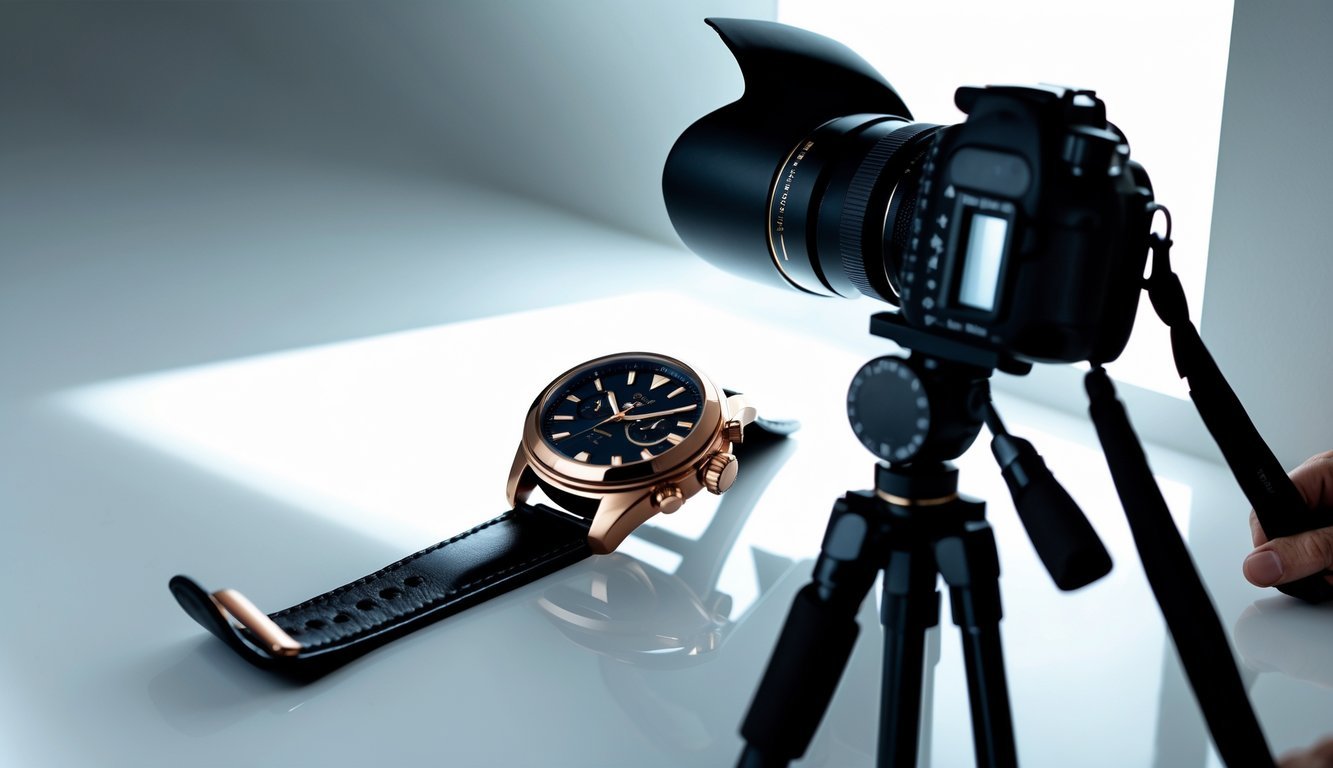Great watch photos can make all the difference between a quick sale and a listing that just sits there. Clear, detailed photos with good lighting and multiple angles show buyers exactly what they’re getting and help build the trust needed for high-value sales.
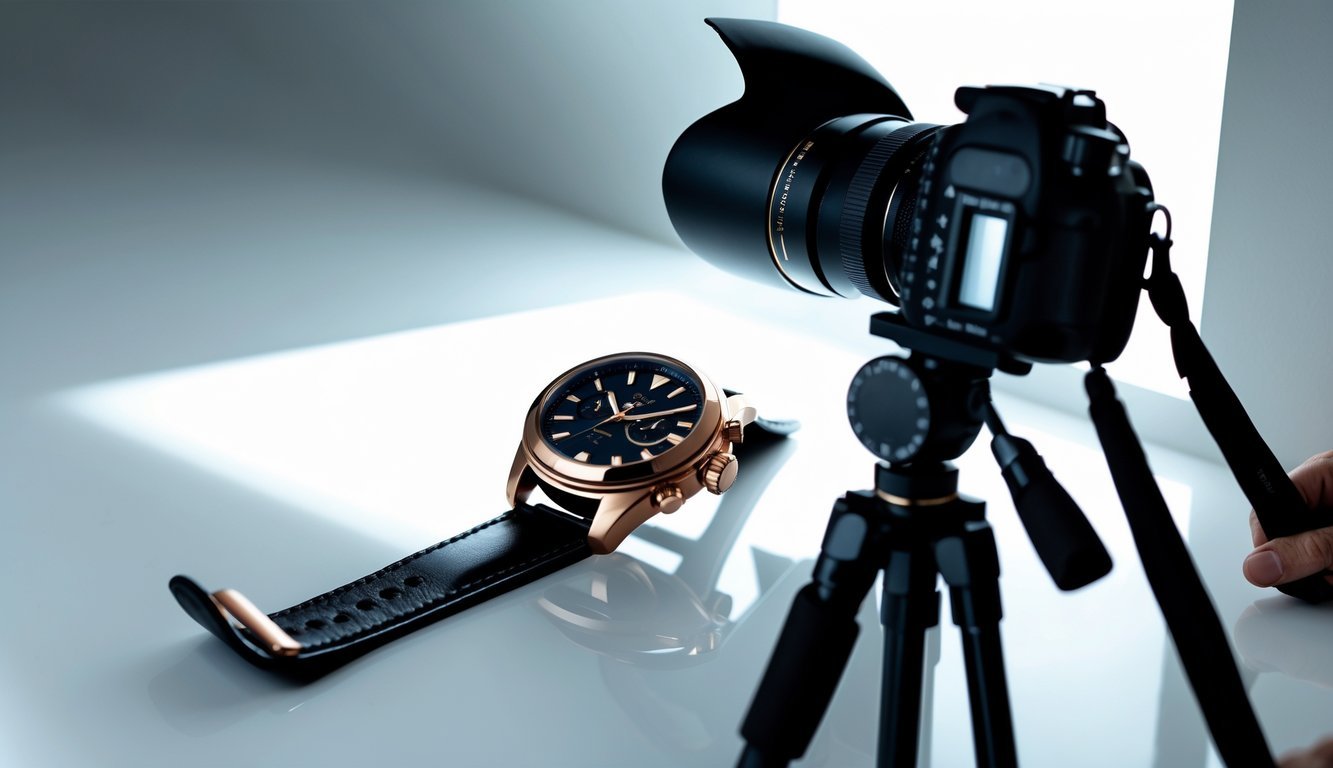
When you’re selling watches online, buyers can’t pick up the watch or see it up close.
Your photos become the main way people judge the watch’s condition, authenticity, and value.
Bad lighting, blurry shots, or missing details can ruin your chances before you even start.
These techniques work whether you’re listing a vintage Rolex or a modern smartwatch.
With some basic gear and a little know-how, you can snap photos that really highlight your watch’s best features and attract serious buyers.
Key Takeaways
- Good lighting and clean backgrounds make your photos look professional and trustworthy.
- Multiple, detailed angles help buyers see the true condition and feel confident in your listing.
- You don’t need fancy gear—simple equipment and easy techniques can really boost your selling success.
Preparation for Watch Photography
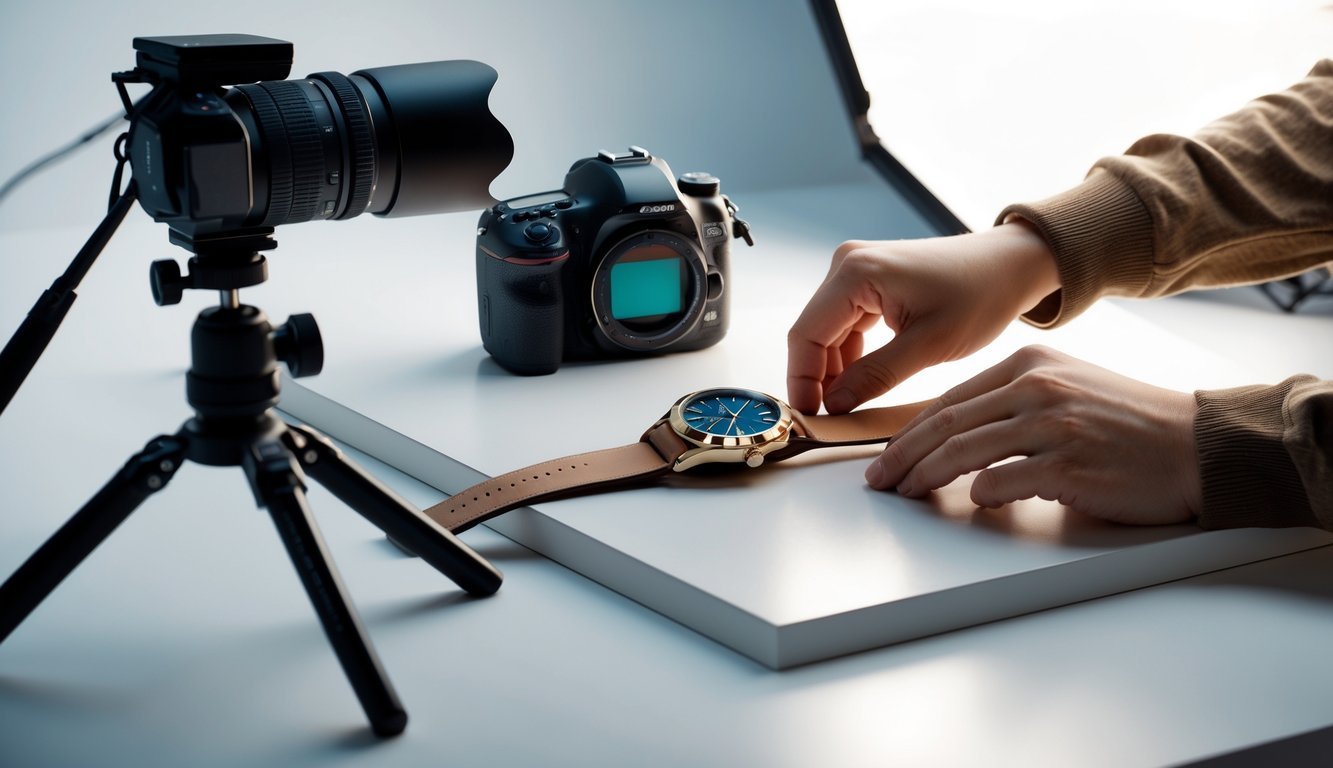
Solid watch photos start with a little prep.
You’ll want the right camera, a clean watch, and a background that keeps things looking sharp.
Selecting the Right Equipment
Camera Options
A DSLR or mirrorless camera gives you the most control over your photos.
You can adjust focus, lighting, and depth of field.
If you’re using a smartphone, pick one with a good camera.
Turn on macro mode for those close-ups.
Essential Lenses
For watches, a macro lens is your best friend.
It’ll catch tiny details like dial textures and engravings.
A 50mm or 85mm lens also does a nice job.
These lenses keep images sharp and avoid weird distortion.
Tripod and Lighting
A sturdy tripod keeps your camera steady.
Shaky photos just don’t look professional.
Set up two softbox lights or LED panels.
Place one on each side of the watch at a 45-degree angle.
If you’re using a phone, a ring light works for even lighting around the watch face.
Cleaning and Preparing Watches
Basic Cleaning Steps
Always clean the watch before you start shooting.
Use a soft microfiber cloth to wipe away fingerprints and dust.
For metal bands, grab a soft brush with soapy water.
Make sure you dry everything before taking pictures.
Removing Scratches and Marks
You can polish out light scratches on the crystal with watch crystal polish and a cotton swab.
If you’re working with luxury brands like Cartier, be extra gentle.
Only use approved cleaning methods to avoid any damage.
Setting the Time
Set the watch to 10:10 for most shots.
This position puts the brand name front and center and looks balanced.
For jewelry watches with lots of decoration, try 2:50 instead.
Sometimes this angle shows off the design better.
Choosing Backgrounds and Surfaces
Background Materials
White seamless paper gives you a clean, professional background.
It bounces light evenly and keeps distractions away.
Black velvet absorbs light and makes metal watches really stand out.
It’s great for luxury pieces.
Surface Options
Try a white acrylic sheet for a reflective surface.
It creates a nice, subtle reflection that adds depth.
A watch pillow props the watch up at the right angle.
Go for neutral colors like white or gray.
Avoiding Common Mistakes
Skip busy patterns or bright backgrounds.
They just pull attention away from the watch.
Leave out jewelry or other items unless you’re selling them too.
Capturing High-Quality Watch Photos
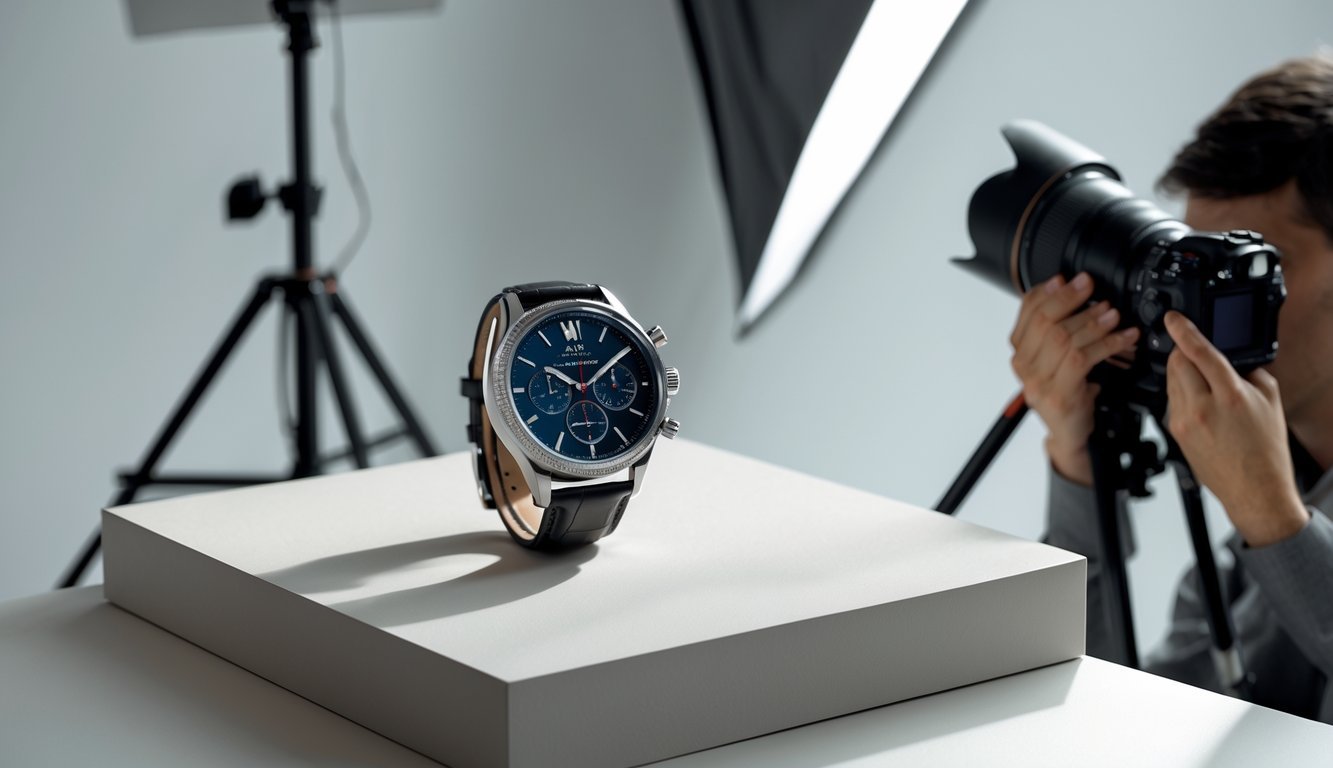
Snapping great watch photos means getting the lighting, positioning, and focus just right.
These tricks help you show off every detail that makes your watch special.
Lighting Techniques for Watches
Natural light works best, honestly.
Set your watch near a big window during the day.
The soft, even light brings out true colors and keeps shadows in check.
Don’t put the watch in direct sunlight.
That just causes glare and hot spots on the crystal and metal.
Use a white foam board or paper as a reflector.
Place it opposite your light source to fill in shadows on the watch face.
For indoor lighting:
- LED light panels with diffusers
- Ring lights for even coverage
- Softbox setups
Stick with large, soft light sources.
Small, bright lights create harsh reflections that hide the details.
Aim your lights at a 45-degree angle to the watch.
This helps avoid glare while keeping the dial clear.
Watch Positioning and Angles
Set the hands to 10:10.
It’s a classic look that shows the brand name and feels balanced.
Prop the watch up on a pillow or small cushion.
That keeps it steady and at the right angle.
Angles you should capture:
- Straight-on dial shot – shows the face clearly
- 3/4 angle – displays case thickness and crown
- Side profile – shows case shape and lugs
- Caseback view – important for vintage or special editions
Tilt the watch slightly toward the camera.
A 15-degree angle helps you dodge those annoying crystal reflections.
Keep the crown at 3 o’clock for side shots.
It just looks right.
Focus, Detail, and Close-Up Shots
Switch to manual focus for sharper shots.
Auto-focus often struggles with shiny watch surfaces.
Focus on the hands or hour markers first.
Those parts matter most on the dial.
Details to catch:
- Serial and model numbers
- Crown and pushers
- Bracelet or strap condition
- Case hallmarks
Snap several shots with different focus points.
You’ll want options when you edit.
Use a tripod to keep things steady.
Even a little shake can mess up detail shots.
Set your camera to the smallest aperture that still gives you sharp focus.
Usually, f/8 to f/11 works well.
Showcasing Brand Details and Features
Make sure the brand name is clear in your main shot.
For luxury brands like Cartier, the logo really matters.
Photograph any complications or special features.
Chronographs, date windows, GMT hands—these boost value.
Brand elements to show off:
- Logo placement and condition
- Model name on the dial
- Case engravings
- Certificate or warranty cards
Get a shot of the clasp and any brand markings on the bracelet.
These details help prove the watch is real.
If the watch has a display caseback, photograph the movement.
Collectors love that.
Include original packaging or papers in separate photos.
These extras can really bump up the value.
Frequently Asked Questions
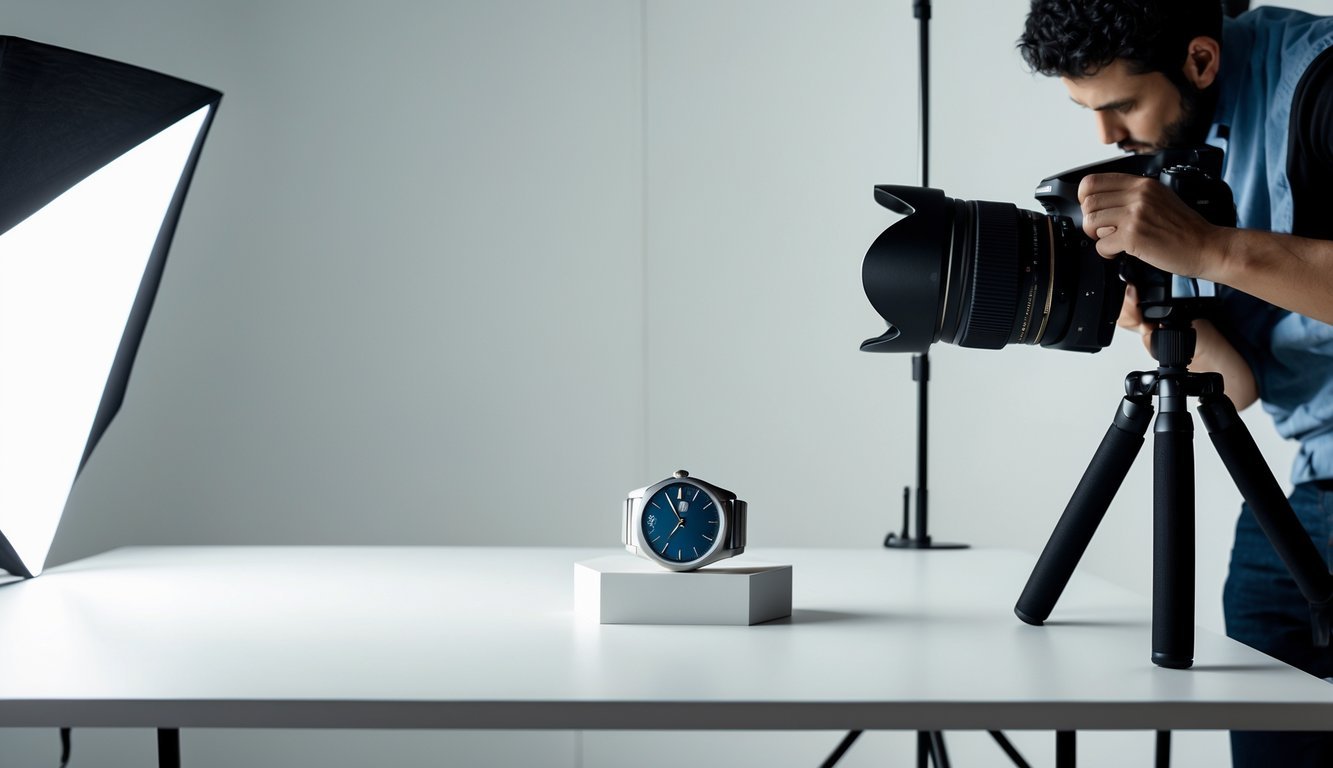
Good lighting creates even shadows and highlights, making watch details pop.
Camera settings like aperture and focus modes help you get sharp, eye-catching images.
What lighting techniques should be used for capturing watches for online listings?
Natural light from a big window usually works best.
Put your watch near the window, but not right in the sun, to avoid harsh shadows.
Grab a white foam board or poster board and set it on the opposite side of your light source.
This fills in shadows and gives you even lighting across the watch face.
Skip overhead ceiling lights.
They throw dark shadows under the watch and make the dial tough to read.
If you’re using artificial lighting, try two desk lamps with daylight bulbs at 45-degree angles.
Put one on each side for balanced light.
A light tent or softbox can help diffuse harsh light and cut down on glare.
You can even make one with white fabric or tissue paper over a wire frame.
What are some creative watch photography ideas to make listings stand out?
Put your watch on textured surfaces like wood grain, leather, or fabric.
These backgrounds add interest but don’t distract from the watch.
Show different angles—straight-on dial shots, side profiles, and close-ups of the crown, pushers, or complications.
Use props that fit the watch style.
Sports watches look cool with athletic gear, while dress watches go well with formal accessories.
Try lifestyle shots—set the watch near a coffee cup, notebook, or car keys.
It helps buyers picture themselves using it.
Take macro shots of the movement if there’s an exhibition caseback.
Collectors and enthusiasts will appreciate those details.
How can I create a professional watch photography setup at home?
Start with a clean, flat surface like a table or desk.
Cover it with white paper or fabric for a seamless background.
Place your watch about 12 inches from the camera.
That distance avoids distortion but still fills the frame.
Use a tripod to keep things steady and sharp.
Even tiny movements can blur details like hour markers or text.
Set up your lighting before you place the watch.
Play around with positions to see what looks best for your particular model.
Keep cleaning cloths, extra straps, and positioning tools handy.
Staying organized makes longer shoots easier.
What tips are there for taking high-quality watch photos using a smartphone?
Wipe your phone’s camera lens before you start.
Smudges and dust can make your photos look blurry.
Turn on macro mode if your phone has it.
This helps you focus on little details like dial text and hour markers.
Tap the watch face on your screen to set focus and exposure.
That way, the key part of your shot stays sharp and well-lit.
Turn off your phone’s flash and use natural or ambient light instead.
Flash just adds glare to the crystal.
Take several shots from different angles and distances.
Pick the best ones later and delete the rest.
Hold your phone with both hands and brace your elbows against your body for steadier shots.
It really helps reduce camera shake.
How can I effectively photograph a watch with a model to enhance online sales?
Pick a model whose wrist size matches your target buyer.
The watch should look comfortable and proportional.
Ask the model to keep their hand and arm relaxed.
Stiff or awkward poses just distract from the watch.
Stick with simple, solid-colored clothing.
Busy patterns or bright colors can pull attention away.
Have the model’s watch-wearing hand a little forward, closer to the camera.
This makes the watch look bigger and more prominent.
Shoot different wrist positions—palm down, palm up, and from the side.
Each angle shows off the watch in a new way.
Keep the focus on the watch face, not the model’s face or anything else.
The watch should always be the center of attention.
What type of camera settings are recommended for detailed and appealing watch photography?
Try using aperture priority mode with your f-stop set between f/8 and f/11.
That way, you’ll get enough depth of field to keep the whole watch face sharp.
Set your ISO as low as your camera allows, usually 100 or 200.
Lower ISO means less grain, so your photos will look cleaner and more polished.
Pick single-point autofocus and aim it right at the center of the watch dial.
This way, the main part of your image will stay crisp.
Go for a shutter speed fast enough to avoid camera shake, like 1/125th of a second or quicker.
If you need to slow it down, just use a tripod.
If your camera lets you, shoot in RAW format.
Editing exposure, color, and sharpness later will be way easier with RAW files.
Set white balance manually, or pick daylight if you’re near a window.
That’ll help you avoid weird color casts that can make the watch look off.


